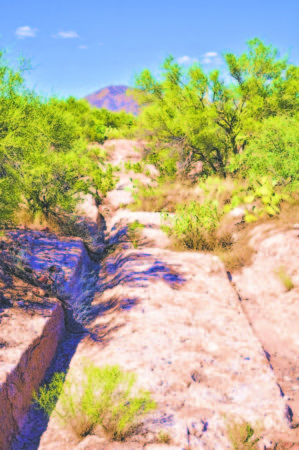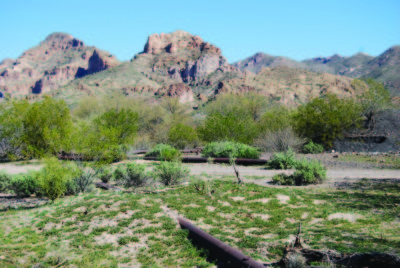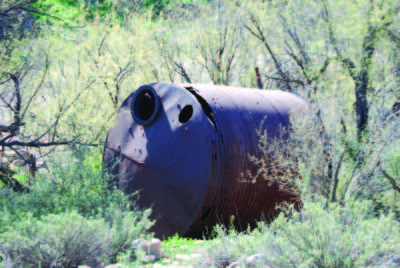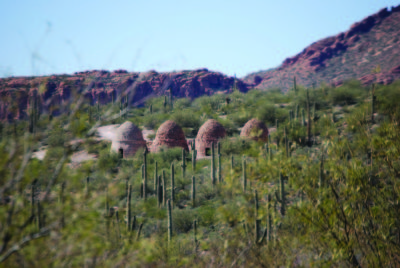
The ruts in the road are all that remain of a wagon trail leading from Superior to the mining town of Pinal City.
A ghost town is defined as a town or city that has been abandoned due to a natural or human made disaster or loss of economic viability or population to sustain a post office. In the western United States there are many mining boom towns that were abandoned after the mines or smelters closed down. There are a number of ghost towns along the Copper Corridor area. Many of them were once promising mining camps whose population left when the ore bodies played out. Some of these ghost towns were in the Oracle area: American Flag 1880 – 1890 & Manlyville 1881 – 1888.
In the Mammoth and Dudleyville areas there was Camp Grant 1875 – 1879, Schultz 1894 – 1902, Tiger 1939 – 1954, Copper Creek 1906 – 1942, Alma 1891 – 1898, Mesaville 1878 – 1888, Sombrero Butte 1919 – 1945.

You can still see a few foundations of the buildings at the Cochran townsite. There is an old rusted water tank, a slag dump and water pipe laying on the grounds.
Along the Gila River and surrounding hills in the Hayden-Winkelman and Kearny areas were a number of mines and the camps that grew around them. These included Troy 1901 – 1910, Cochran 1905 – 1915, Belgravia 1918 – 1930, Riverside 1877 – 1900, Kelvin 1900 – 1956, Christmas 1905 – 1935, Ray post office established in 1899, Sonora 1907 – 1965, and Barcelona. The town of Ray was built in 1909. Sonora and Barcelona were located in the town of Ray area but due to the prejudices of the time, were segregated communities. Sonora was mostly Mexican and Mexican-American workers and Barcelona were workers from Spain. All three towns are buried beneath the open pit mine of GRUPO – ASARCO. Relocation of the workers began in 1958 and lasted until 1965.

Rusted water tank at the Cochran site.
The ghost towns around the town of Superior, established in 1902 include Queen 1881, Silver King 1877 – 1912, Picket Post 1878 changed to Pinal 1879 – 1891, Magma 1915 – 1928, Reymert 1880 – 1898 and DeNoon 1890 – 1891.
The Globe-Miami mining district included the ghost towns of McMillenville 1877 name changed to McMillen 1878 – 1882, Nugget 1881 – 1884, Copper Hill 1908 – 1933, Pioneer 1882 – 1885, and Stanton 1880 – 1882.

On a hillside across the Gila River you can see the bee hived shaped charcoal kilns. Many people associate them with Cochran and call them the coke ovens but they were there before Cochran was built.
